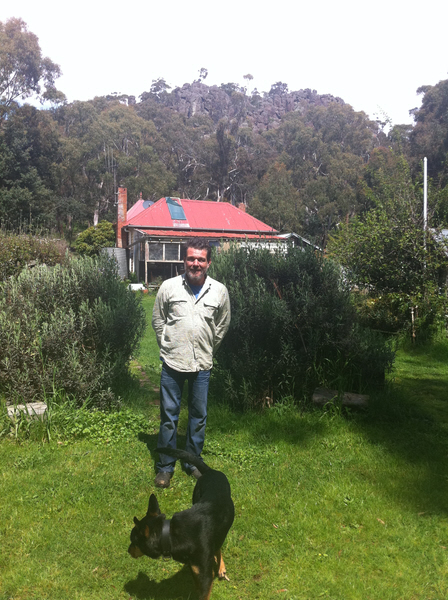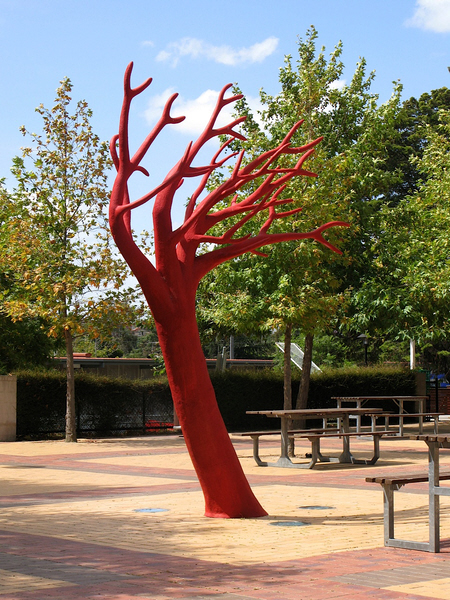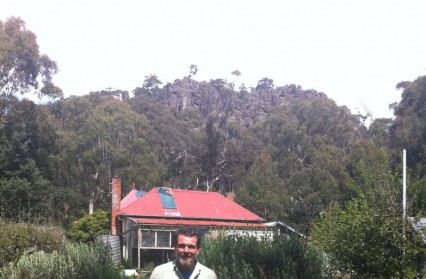Lowri Haf Cooke profiles Tim Jones, a Welsh artist that has found significant success in Australia, as he recalls his early influences and the impact of Wales on his art.
1975 was a vintage year at the Cinema as Jaws, Nashville and One Flew Over The Cuckoo’s Nest kept worldwide audiences enthralled. Another film to cast a spell over the masses in August of the same year was the haunting and lyrical Picnic at Hanging Rock by the Australian auteur Peter Weir. Adapted from the mysterious novel by Joan Lindsay, this dreamy yet sinister outing followed the intriguing tale of a group of Victorian-era schoolgirls who were permitted a day-trip to a sacred mountain by their disciplinarian headmistress – played by Llanelli-born actress Rachel Roberts – and never came back.
Viewers’ attention was captured in style by the Botticelli angel-like Miranda (Anne-Louise Lambert) who foresaw her future and was drawn to her death. Due to the film’s eerie and ambivalent ending, Welsh artist Tim Jones still hears the haunting sound of visitors calling her name in vain from his home in the shadow of Hanging Rock.
Human voices are not the only sounds to be heard from the cluttered kitchen of Rock Bottom cottage. The cheerful chirping of the violet and red-feathered Rosellas form a significant layer of his daytime soundscape, whilst keening Koalas and hooting owls enhance the evening chorus. These native creatures, along with the neighbourhood kangaroos, are a constant inspiration to the artist, originally from Downing near Holywell in North Wales, who has lived in the area since the early 1990s after making the move from the city of Melbourne, an hour’s train-ride away.

Home to all these wildlings is the canopy of Blackwood, Peppermint and Manner Gum trees that forms a lush green carpet at the foot of Hanging Rock. ‘When I came here first,’ says Jones, ‘I felt a real longing for the oak trees of Downing. The knotted, claw-like branches of the native trees were totally alien to me. But after a while something in me clicked, and I began to see their beauty. Now they form a large part of my work.’
Indeed, these trees and many others are the inspiration for a number of striking commissioned works by the artist, that include large-scale bronze sculptures as well as intricate engravings created from the boxwood he imports from the UK.
Amongst the thousands of wood engravings to be found in his light-filled studio – produced by a 19th Century printer that he bought at auction in the neighbouring town of Ballarat – is a collection by the name of Gwibnant, that chronicles a number of works, including a haunting picture of Coed y Garreg near Holywell, along with a recent series called Bedd Gelert, inspired by the famous Welsh folk tale.
‘I’ve been here almost thirty years, but it really is true what they say; it’s your earliest memories that leave the most lasting impressions, and it’s these stories and places that I remember enjoying as a child.’
Born in Prestatyn in 1962, Jones was brought up at Downing on the outskirts of Whitford. He recalls a creative upbringing in a happy home, and his father’s work restoring and selling gypsy caravans. Among his varied customers were members of the Romany traveller community, the children’s novelist Roald Dahl and rock legends Led Zeppelin and Black Sabbath.
Another of his father’s acquaintances was Sir Peter Blake – the pop artist famed for the iconic collage that he created for The Beatles’ Sergeant Pepper’s Lonely Hearts Club Band album cover. It was he who left the most lasting impression on Tim. ‘He often came to visit my father, and one afternoon he taught me about wood engraving. A few months later I received an engraving set for Christmas – I didn’t stop after that.’
Examples of Tim’s artworks are hung on every wall at his cosy country cottage. In the kitchen, Hank Williams stares down over the gas oven, one of a series of prints inspired by American country music artists, whilst in the bedroom, pride of place is given to a sparkling watercolour of the family cat hiding amongst the leaves, captured when he was eleven years old.
Despite his artistic gifts as a child, Tim had problems reading and writing that were not fully addressed until he was thirteen years old, when it was suggested to his parents that he might have dyslexia. ‘Neither of them had ever heard of the condition before, but the educational psychologist’s explanation made a lot a sense to me. He said that to a child with dyslexia, everything was upside down – rather like Australia. That image stayed with me, and planted a seed inside to visit this faraway place that would make perfect sense to me. In a way that’s what led me here. That and Skippy, and Rolf Harris of course!’
Tim Jones showed great promise at school in Holywell and went on to study at Wrexham School of Art, before gaining a first class honours degree in Painting and Printmaking in Newcastle Polytechnic. He lived for a while in London and New York, but in 1984 he made the move to Australia, whereupon he completed his diploma and a Masters degree in Sculpture, and was floored by the vast expanse of bright blue sky and endless, dramatic, landscape that he admits took quite a few years getting used to.
Today, Tim Jones is considered one of Australia’s foremost contemporary artists; a number of his works reside on the walls of the country’s national galleries, and form part of numerous private collections both at home and abroad. Several of his large-scale bronze trees are to be found in public arenas including the dramatic Blasted Red Tree that welcomes visitors to the Chadstone Campus of Holmesglen Institute, Victoria.

Following spells of teaching in universities and art-schools all over Australia, he is a popular lecturer at the Centre for Adult Education, located in the bowels of Melbourne Central Library. ‘My Dad doesn’t really understand why I continue to lecture, but I enjoy having that balance in my life, along with regular trips to Melbourne, which is truly a fantastic city.’
Since arriving in Australia in his early twenties Jones has made several pilgrimages back home to visit his sister and parents. But following a painful divorce six years ago, and with two young children to provide for, the long haul trip back to Wales has been off the radar of late. But as Eli, 14, and Arabella, 10, grow older, Tim looks forward to exploring opportunities to return to Wales and exhibit his work in his homeland.
‘The last time I went back, almost seven years ago now, I travelled quite a bit, revisiting several places in Snowdonia, as well as a research trip Gregynog Hall – home of the Gregynog press – and all the way down to Laugharne. It was there that I was given a bollocking by the Lady Mayoress, who thought I was some kind of new age gypsy for parking his batted old van under the ruin’s of the Castle “illegally!”’
That surreal encounter in Laugharne inspired a series of wood engravings based on Under Milk Wood by Dylan Thomas; indeed, Jones counts the Swansea-born bard – along with another Flintshire artist, David Jones – as one of the biggest influences on his work.
Despite his dyslexia, Jones learnt to enjoy reading in his twenties and thirties by consuming everything, from Lewis Carroll to William Blake- another two figures who left a lasting impression on his dreamlike subjects, including an icon he has returned to repeatedly over the years; Blake’s Tree. Today, books themselves form a significant part of his work; quite literally, in some cases. The Yves Klein blue sculpture to be found at the foot of a striking scar tree, is an arresting image, enhanced by the narcotic aroma of chocolate lilies that grow along the wildflower path in the back garden.
A stone’s throw away, the Welsh flag with its fierce red dragon flutters in the wind above the pictures of Tim Jones’ kids on the desk in his studio. Through the window, Hanging Rock continues to exude a magnetic, force over the Welsh artist who lost his accent, broke his heart but found a new lease of life at Rock Bottom.
Tim Jones is a Welsh artist that current resides in Australia – for more information concerning Tim’s recent work visit Australian Galleries. Welsh artist












